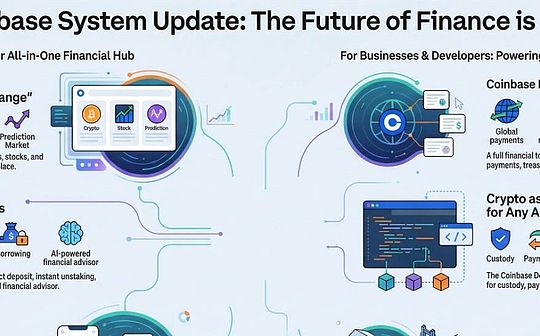
Author: Route2Fi Source: The Black Swan Translation: Shan Ouba, Bitchain Vision Realm
introduce
Centralized stable currency issuers, such as Tether and Circle, account for about 90%of the stabilized currency market, and have become heavyweights in the cryptocurrency field. The valuations and profits are far beyond traditional financial giants such as Morgan Chase and Belle.Their business model is simple: use the liquidity behind stable coins to support various risk assets.
With the rise of currency interest rates, these entities have transformed into a “withdrawal machine” with rich profits.Tether and Circle created more than $ 10 billion in revenue in 2023, with a valuation of more than $ 200 billion.These wealth of wealth will not be shared with users who have successfully contributed to them.The goal of USUAL is to make users the owner of agreement infrastructure, funds and governance.Through its re -distribution of 100% value and control, the USUAL ensures that its community has dominance.
The USUAL protocol distributes to tokens to users and third parties contributed, re -adjusted financial incentives and returned power to participants in the ecosystem.
USUAL is completely changing the world of stable currency by introducing the function of decentralized RWA stabilization.By depositing income assets (originally USYC), users can obtain speculative income successfully linked to the agreement through the USUAL GOVERNANCE tokens.The income is designed to exceed the risk -free income of basic assets.Its mission is to transform the stable currency holder into a profit owner.
Transform the user into an owner
TLDR:
Although traditional stable currency like Tether will prevent users from participating in income and growth, and income -based assets will only bring benefits without bringing growth, but USUAL has the advantages of the two.Using usual, you can gain income and growth potential at the same time.
The ownership sharing mechanism creates a positive feedback cycle to ensure the close combination of early contributors and the agreement, so that the USUAL may occupy a considerable market share.Through extensive distribution of ownership, the agreement reward early participants and coordinate the interests of all stakeholders.
Stable coins like Tether collect users’ cash and earn interest, and users cannot obtain benefits nor to get the issuer’s growth.As a exchange, users will receive a tokens for DEFI, but they will not obtain any benefits from profits.
What if the user can benefit from interest, growth and practicality without compromise?
This is where the USUAL intervention is: a decentralized stable currency issuer, the user is the owner.
At present, there are three types of stable currency issuers on the market:
-
TestherKeep all income and allocate all of them to the shareholders of Tether.Users have a stable currency compatible with DEFI, but they miss the opportunity to increase income and protocol growth.
-
Income stable coins issued by tokens such as ONDO or MountainIt marks the major changes in the field of stabilizing currency, and it re -distributes basic income to users through the permitted stabilization currency.Users can get benefits, but will not be affected by the growth of agreement: whether the USDM TVL is $ 100 million or $ 100 billion, the user is still “Only “Get 5%.
-
UsualFurther, the value is re -assigned through the $ usual token, giving user agreement ownership.Unlike the income sharing model, USUAL concentrates all the value created into its vault, and 90% of them are allocated to the community by governing the token.Users can obtain two aspects at the same time: utility, income and growth.
-
Speculating income provided by the form of usual governance to tokens.The income fluctuates based on the $ usual price determined by the secondary market.
-
Based on the currency interest rates of basic treasury coupons, at least risk -free return.This yield increased by the floating supply of non -productive USD0 proportion.
-
VC -free: 90% of the USUAL tokens are allocated to those who contribute value and income to the agreement, and they are mainly allocated through USD0 TVL.Investors, teams and consultants and other contributors do not exceed 10%of the total supply, thereby protecting users from excessive dilution.
-
Issuance of linked to cash flow: The issuance of USUAL is directly related to the future cash flow generated by stable currency mortgages.The USUAL will be cast every time they pledge 0 US dollars. As the agreement income increases, the token supply will increase.
-
Control dilution: The release model of USUAL aims to achieveTighteningIt is very similar to Bitcoin.The inflation rate is calibrated and maintainedBelow the increase in agreement revenue, ensure that the tokens issue speed does not exceed the economic expansion of the agreement.
-
Financial management: USUAL holders will also be able to determine how to manage financial and agreement revenue, and to destroy or distribution of income through tokens.
-
Measure voting: USUAL holders guide the liquidity of the agreement and affect key decisions to ensure that they play an active role in the development and success of the agreement.
-
Pledge reward: Tokens holders can get income by pledged their USual tokens.When the USual tokens are pledged, they become USUAL+ -holding $ usual+ to allow the holder to get up to 10% of the newly cast $ usual tokens, and the specific proportion is calculated according to the specified distribution rules.
-
Loan:Morpho, Euler, Term Finance, Sturdy, ARKIS, PWD, LLAMALEND
-
Cross -chain:Chainlink, layerzero, axlar, socket (discussion)
-
income:Etherfi, Pendle, Origami, Spectra, Equilibria, Penpie, StakeDao
-
Subsidies:Karak
-
L2 network:Arbitrum, Base, BNB, MANTLE, Starknet, Mode, Berachain, Monad, Movement, Sui, Sui
-
Decentralization exchange/liquidity:Curve, Pancakeswap, Balancer/Gyro, MAVERICK, Uniswap
-
French currency in -exit:Banxa, holyheld
-
USD0 ++ holders can earn 3 points per other each day.
-
USD0/USD0 ++ CURVE LP holders can get 3 points of points for each USDO every day.
-
USD0/USDC Curve LP holders can get 1 point every day with USDO or USDC.
-
There are still many other opportunities, such as Pendle, Morpho and so on.
This is the way USUAL transforms users into direct owners, allowing them to control the infrastructure, finance and future cash flow of the agreement.
Common token infrastructure
>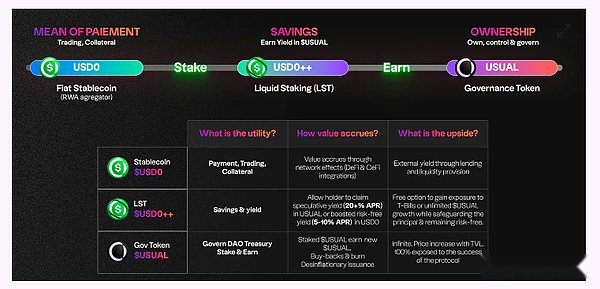
This protocol is constructed around three tokens:
USD0
USD0 is a stable currency linked to the US dollar to the USD, which aims to act as a payment method, trading opponent and mortgage token in the agreement.It provides better alternatives for USDC and USDT, while in accordance with US and EU regulations.This institutional stable currency can be used by retail investors and DEFI users.
USD0 converges the Treasury Bond of the U.S. Treasury and creates a safe, far away from bankruptcy assets, which has nothing to do with traditional bank deposits.It can be completely transferred without permission, and it can be seamlessly integrated into the DEFI ecosystem.
USD0 mobile bond (USD0 ++)
>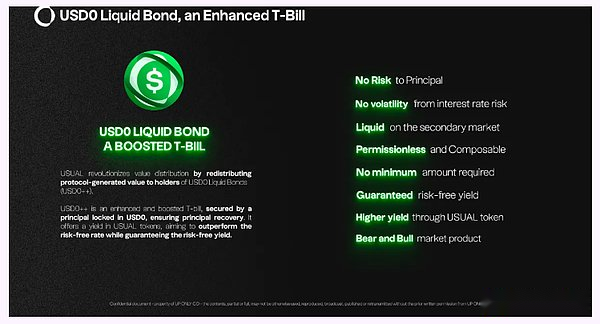
If USD0 holders want to make their stable coins benefit, they must pledge the stable currency to get the efficient LST of RWA.USD0 ++ is the liquidity representative of pledged USD0.By locking capital, users have the opportunity to receive $ usual every day.If they have not received $ usual, they can exercise no risk income rights every six months.USD0 ++ is completely combined in DEFI, similar to USD0.
Therefore, USD0 ++ is a enhanced U.S. Treasury bond, which gives you the right:
$ Usual -governing tokens -the benefits of using USD0
Usual reward USD0’s growth, adoption and use in the ecosystem.The usage of the USD0’s adoption rate is continuously improved, combining incentive measures with the expansion and utilization of users who contribute to the agreement.
$ Usual token is a governance tokens in the USUAL ecosystem, which represents the income of the agreement and authorizes users to participate in the decision -making process related to the operation of the agreement and fund management.
The USUAL aims to achieve long -term value growth, and its circulation rate intentionally maintains below the growth of agreement revenue to increase the internal value over time.According to the concept of its community first, 90% of the tokens are allocated to the community, and only 10% are left to the team and investors.
growing up
In the summer of 2024, USUAL showed the highest TVL growth rate of stable coins.
>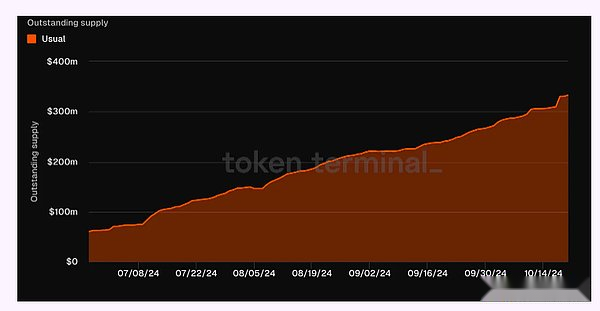
>
USUAL has experienced rapid growth, and the total lock value (TVL) has reached 330 million US dollars within three months.This impressive expansion has made it one of the best performances on Ethereum in the summer of 2024.
USUAL has more than 40,000 users from various integrated platforms, and has become the top participants in the field of stabilized currency, ranking the 13th major stable coin issuer.In addition, it ranks in the top five mining pools in Curve and is in a leading position in Morpho and Pendle’s TVL.
The agreement is expected to reach $ 15 million in annual income, further consolidating its position in the DEFI ecosystem.
team
>
Pierre Person, Laywer CEO, Presidential Counselor, Former French Member, Presidential Party Vice ChairmanTwo years ago, began to create a stable currency protocol containing cryptocurrencies and decentralization.While serving as a parliamentarian, he was committed to the development of the French cryptocurrency supervision framework.
Hugo Sallé de ChouAs a fintech entrepreneur, the chief operating officer, HUGO created Pumpkin, a Puff start -up company similar to Venmo in 2014, challenged the traditional banking system and obtained 2 million active users during its peak.
Adli Takkal Bataille, DEO
A real cryptocurrency OG entered the block#271376 in 2013. He created a French cryptocurrency organization called Le Cercle Du Coin, and since 2018 as a consultant to consult multiple projects.
In 2020, he established a cryptocurrency native venture capital fund -Shift Capital in Luxembourg, who currently only conducts market neutral investment.Twitter | linkedin
Pierre Cumenal, Chief Financial Officer
PETE has a master’s degree in applied mathematics and quantitative finance. He worked at Natixis and Amundi. He later moved to London and served as a quantitative analyst in the Bank of Paris.Here, he has developed the pricing model of strange derivatives across different markets.Recently, he has developed a completely decentralized option agreement.
supporter
USUAL raised $ 7 million through three rounds of financing, and currently has 170 investors’ support: venture capital, angel investment, agreement and DAO.
>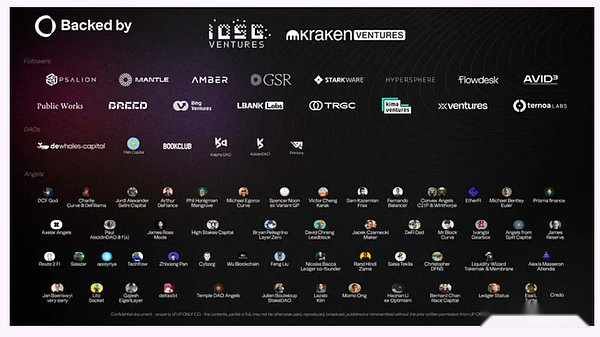
Investors include Dewhales, iOSG, Kraken Ventures, GSR, PSALION, Hypersphere, Lbank Labs, Public Works (co -founder of Gitcoin), Kima Ventures, and Breed (former Circle executives).
These 120 angel investors include FRAX SAM, Curve’s Charlie and Michael, DEFI DAD, DCF God, CHUD, Lux Temple, Amber Group, Gearbox’s Ivan, Convex founders, Zoomer Oracle, etc.
USUAL token economics
Today, many design of tokens are defective.They usually follow the una -optimized copy and paste model, which is difficult to balance short -term traders and long -term buyers, which leads to selling pressure without continuous demand or effective growth.In addition, the correlation between the value, governance and income potential of these tokens is poor, focusing on speculative transactions rather than long -term utility, resulting in hype, leading to price swelling.Interests are often inconsistent. The founders and inside personnel hold a large number of tokens, but users who create value are not fully served, and they face the depreciation of the tokens caused by inflation.
The USUAL achieved long -term sustainable value growth and practical utility by combining the interests of users, contributors and investors, thereby forming a sharp contrast.
The USUAL tokens are the main governance tools in the USUAL framework.At the time of launch, the USUAL tokens provide economic benefits and governance capabilities for holders.The reward is distributed to the holder in the form of a $ usual token. The value of these tokens originated from its economic rights and the actual benefits generated by stable currency mortgages.
USUAL tokens allocation
Most $ usual tokens are distributed to users who have contributed to the development of agreement and value creation.The model aims to protect the community from any dilution caused by teams or investors, and ensure that incentive measures are consistent with those who promotes success.
>
Detailed distribution
Divided into various typesThe allocation channel can be modified by governing voting, Each channel has different uses:
>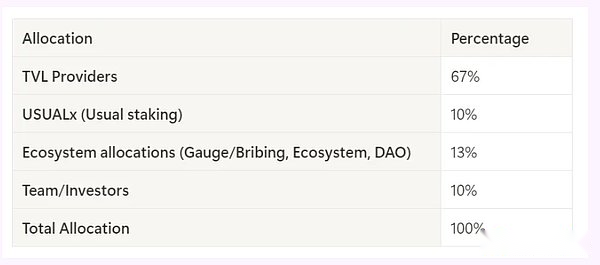
Partnership
>
Integration is the key factor of USUAL expanding the total lock value (TVL), increasing user stickiness, and building a moat.In order to allow you to better understand the USUAL partner ecology, the following lists are listed or being discussed, and classified:
Integrated to be realized:
MORPHO, Etherfi, Pendle, Symbiotic, Eigenlayer, Gainstrade, Reserve, DTRINITY, POLYNOMIAL, BUBBLY, Hourglass, SuperForm, Brahma, Abracadabra, Timeswap, Gearbox, Contango, Dyad, Idle, NOTIONAL, Exponential.fi, Curvance, Fluid, THETANUTS,,, THETANUTS,,, THETANUTS,,, thetanuts,,Mach, GMX, Vertex, Bunni, VDex.
Participate in pre -release
Pre -release is the USUAL airdrop plan, from July 10 to mid -November.
7.5% of the USUAL supply will be airdropped and allocated according to the points obtained during the pre -release period.The system rewards daily points based on the USUAL product held by the user.In addition, the cast USD0 ++ can get instant points.
The operation of the integration system is as follows:
Daily points:
Visit commonly used DAPP to understand various participation methods, especially through Pendle, Etherfi, Morpho, Curve, Equilibria, Karak, etc.


